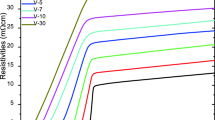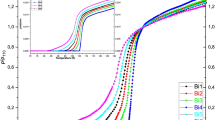Abstract
In the current study, the effect of vanadium particles on the electrical, superconducting, crystallographic, key structural and morphological features of Bi1.8Sr2.0Ca2.2Cu3.0VxOy superconducting materials is examined with the aid of powder X-ray diffraction (XRD), scanning electron microscope (SEM), electron-dispersive X-ray (EDX) and dc electrical resistivity over the temperature (ρ-T). The vanadium-added Bi1.8Sr2.0Ca2.2Cu3.0VxOy (Bi-2223) superconducting materials are prepared within the molar ratios between x = 0.00 and 0.30 using the conventional solid-state reaction technique. The temperature-dependent electrical resistivity measurements show that the existence of vanadium atom in the superconducting system damages seriously the Bi-2223 (high-Tc) phase content in the crystal structure as a result of the formations/disappearances of new impurity phases. On this basis, the amplitude Ψ0 of wave function founded on the super-electrons is considerably reduced with the vanadium addition. The critical onset and offset transition temperature values truncate from the values of 110.92 K and 97.45 K to 103.17 K and 18.38 K in case of the maximum vanadium addition level of x = 0.30. Similarly, the XRD results present that the average crystallite size and c-axis length parameters are noted to decrease considerably whereas a-axis length, strain and relativistic dislocation density ratios are calculated to enlarge harshly depending on the addition content level. It is also obtained that the vanadium inclusions lead to increase seriously the permanent crystal structure problems, disorders, misorientations, lattice strains, crack-producing omnipresent flaws and grain boundary coupling problems in the active Cu–O2 consecutively stacked layers in the superconducting core, being assured by SEM analyses. Besides, the SEM results show that the enhancement of vanadium addition level in the crystal structure damages remarkably the flaky layers of platelet-like shape for the grains. In fact, the excess vanadium addition seriously damages the general characteristic view (flaky layer structure) of Bi-2223 compound. Based on the EDX findings, the main reason for the degradation of fundamental characteristic properties of Bi-2223 system may stem from the possible replacement of aliovalent vanadium impurities for the copper-sites in the crystal structure. Namely, the vanadium addition in the crystal structure is ploughed to improve the fundamental crystallographic and electrical-superconducting features of bulk Bi-2223 superconducting materials.







Similar content being viewed by others
References
K. Koyama, S. Kanno, S. Noguchi, Electrical, magnetic and superconducting properties of the quenched Bi2Sr2Ca1-xNdxCu2O8+y system. Jpn. J. Appl. Phys. 29, L53–L56 (1990)
H. Miao, M. Meinesz, B. Czabai, J. Parrell, S. Hong, Microstructure and J(c) imrovements in multifilamentary Bi-2212/Ag Wires for high field magnet applications. AIP Conf. Proc. 986, 423–430 (2008). https://doi.org/10.1063/1.2900377
H.K. Onnes, Further experiments with liquid helium. D. On the change of electrical resistance of pure metals at very low Temperatures, etc. V. The disappearance of the resistance of mercury. Koninklijke Nederlandsche Akademie van Wetenschappen Proc. 14, 113–115 (1911)
S.B. Guner, Y. Zalaoglu, T. Turgay, O. Ozyurt, A.T. Ulgen, M. Dogruer, G. Yildirim, A detailed research for determination of Bi/Ga partial substitution effect in Bi-2212 superconducting matrix on crucial characteristic features. J. Alloy. Compd. 772, 388–398 (2019). https://doi.org/10.1016/j.jallcom.2018.09.071
H. Maeda, Y. Tanaka, M. Fukutomi, T. Asano, A new high-Tc oxide superconductor without a rare-earth element. Jpn. J. Appl. Phys. 27, L209–L210 (1988)
S.E.M. Ghahfarokhi, M.Z. Shoushtari, Phys. B 405, 4643–4649 (2010)
G. Yildirim, S. Bal, A. Varilci, Effect of Magnetic field direction on magnetoresistivity, activation energy, irreversibility and upper critical field of Bi-2212 thin film fabricated by DC sputtering method. J. Supercond. Novel Magn. 25, 1665–1671 (2012). https://doi.org/10.1007/s10948-012-1497-1
H. Hilgenkamp, J. Mannhart, Grain boundaries in high Tc superconductors. J. Rev. Mod. Phys. 74, 485–549 (2002). https://doi.org/10.1103/RevModPhys.74.485
M. Dogruer, C. Terzioglu, G. Yildirim, M. Pakdil, Y. Zalaoglu, Decrement of crack propagation in bulk Bi-2223 superconducting ceramics with Sn-diffusion annealing temperature. J. Mater. Sci. 26, 6013–6019 (2015). https://doi.org/10.1007/s10854-015-3177-y
B.Z. Sun, X. Yang, H.C. Chen, J. Tan, Y. Qi, Structural study of lanthanum-doped Bi-2212 compounds: Site occupancy and lattice distortion. J. Alloys Compd. 749, 961–966 (2018). https://doi.org/10.1016/j.jallcom.2018.03.340
A.I. Abou-Aly, S.A. Mahmoud, R. Awad, M.M.E. Barakat, Electrical resistivity and magnetoresistance studies of (Bi, Pb)-2223 phase substituted by Ru. J. Supercond. Nov. Magn. 23, 1575–1588 (2010). https://doi.org/10.1007/s10948-010-0815-8
G. Yildirim, E. Yucel, S. Bal, M. Dogruer, A. Varilci, M. Akdogan, C. Terzioglu, Y. Zalaoglu, Investigation of structural and superconducting properties of Cr added Bi-2212 superconducting ceramics. J. Supercond. Novel Magn. 25, 231–237 (2012). https://doi.org/10.1007/s10948-011-1284-4
M. Dogruer, Y. Zalaoglu, A. Varilci, C. Terzioglu, G. Yildirim, O. Ozturk, A Study on magnetoresistivity, activation energy, irreversibility and upper critical field of slightly Mn added Bi-2223 superconductor ceramics. J. Supercond. Nov. Magn. 25, 961–968 (2012). https://doi.org/10.1007/s10948-012-1403-x
N. Loudhaief, M.B. Salem, H. Labiadh, M. Zouaoui, Electrical properties and fluctuation induced conductivity studies of Bi-based superconductors added by CuS nanoparticles synthesized through the aqueous route. Mater. Chem. Phys. 242, 122464 (2020). https://doi.org/10.1016/j.matchemphys.2019.122464
Y.J. Ko, J.Y. Oh, C.Y. Song, D.S. Yang, D.H. Tran, B. Kang, Phase transition of (Bi, Pb)-2223 superconductor induced by Fe3O4 addition. Prog. Supercond. Cryog. 21, 1–5 (2019). https://doi.org/10.9714/psac.2019.21.4.001
D.R. Mishra, S.V. Sharma, R.G. Sharma, Role of vanadium in Bi-2223 ceramics. Pramana J. Phys. 54, 317–330 (2000). https://doi.org/10.1007/s12043-000-0027-z
Y. Zalaoglu, G. Yildirim, H. Buyukuslu, N.K. Saritekin, A. Varilci, C. Terzioglu, O. Gorur, Important defeats on pinning of 2D pancake vortices in highly anisotropic Bi-2212 superconducting matrix with homovalent Bi/La substitution. J. Alloys Compd. 631, 111–119 (2015). https://doi.org/10.1016/j.jallcom.2015.01.095
J. Ekin, Experimental Techniques for Low-Temperature Measurements: Cryostat Design, Material Properties and Superconductor Critical-Current Testing (Oxford University Press, New York, 2006).
M. Li, Y. Zhang, Y. Li, Y. Qi, Granular superconductivity in polycrystalline Bi2Sr2CaCu2O8+γ by homovalent La substitution on Bi sites. J. Non-Cryst. Solids 356, 2831–2835 (2010). https://doi.org/10.1016/j.jnoncrysol.2010.09.036
X. Xu, J.H. Kim, S.X. Dou, S. Choi, J.H. Lee, H.W. Park, M. Rindfleish, M. Tomsic, A correlation between transport current density and grain connectivity in MgB2/Fe wire made from ball-milled boron. J. Appl. Phys. 105, 103913 (2009). https://doi.org/10.1063/1.3129314
A. Ianculescu, M. Gartner, B. Despax, V. Bley, R. Th Lebey, M.M. Gavrila, Optical characterization and microstructure of BaTiO(3) thin films obtained by RF-magnetron sputtering. Appl. Surf. Sci. 253, 344–348 (2006). https://doi.org/10.1016/j.apsusc.2006.06.008
N.K. Sartekin, M. Pakdil, G. Yildirim, M. Oz, T. Turgay, Decrement in metastability with Zr nanoparticles inserted in Bi-2223 superconducting system and working principle of hybridization mechanism. J. Mater. Sci. 27, 956–965 (2016)
G. Burns, High-Temperature Superconductivity: An Introduction (Academic Press, New York, 1991).
R. Awad, A.I. Abou-Aly, M.M.H. Abdel Gawad, I. G-Eldeen, The influence of SnO2 nano-particles addition on the vickers microhardness of (Bi, Pb)-2223 superconducting phase. J. Supercond. Nov. Magn. 25, 739–745 (2012). https://doi.org/10.1007/s10948-011-1334-y
S.B. Guner, Y. Zalaoglu, T. Turgay, O. Ozyurt, A.T. Ulgen, M. Dogruer, G. Yildirim, A detailed research for determination of Bi/Ga partial substitution effect in Bi-2212 superconducting matrix on crucial characteristic features. J. Alloys Compd. 772, 388–398 (2019). https://doi.org/10.1016/j.jallcom.2018.09.071
D.M. Rao, T. Somaiah, V. Haribabu, Y.C. Venudhar, Growth-kinetics of high-Tc and low-Tc phases in Bi2-xPbxCa2Sr2Cu3Oy superconducting compounds. Cryst. Res. Technol. 28, 285–298 (1993). https://doi.org/10.1002/crat.2170280302
J.M. Graybeal, M.A. Beasley, Localization and interaction effects in ultrathin amorphous superconducting films. Phys. Rev. B 29, 4167–4169 (1984)
R.C. Dynes, A.E. White, J.M. Graybeal, J.P. Garno, Breakdown of Eliashberg theory for two-dimensional superconductivity in the presence of disorder. Phys. Rev. Lett. 57, 2195–2198 (1986). https://doi.org/10.1103/PhysRevLett.57.2195
B.D. Cullity, S.R. Stock, Elements of X-Ray Diffraction, 3rd edn. (Pearson, New York, 2014).
M. Dogruer, G. Yildirim, E. Yucel, C. Terzioglu, Role of diffusion-annealing temperature on the microstructural and superconducting properties of Cu-doped MgB2 superconductors. J. Mater. Sci. 23, 1965–1970 (2012). https://doi.org/10.1007/s10854-012-0689-6
X.L. Lin, S.S. Ma, H.Y. Wang, H. Xu, Characteristics of hopping conductivity in one-dimensional binary disordered system with off-diagonal correlations. Acta Phys. Sin. 56, 2852–2857 (2007). https://doi.org/10.7498/aps.56.2852
R. Shabna, P.M. Sarun, S. Vinu, U. Syamaprasad, Charge carrier localization and metal to insulator transition in cerium substituted (Bi, Pb)-2212 superconductor. J. Alloys Compd. 493, 11–16 (2010). https://doi.org/10.1016/j.jallcom.2009.12.047
S. Martin, M. Gurvitch, C.E. Rice, A.F. Hebard, P.L. Gammel, R.M. Fleming, A.T. Fiory, Nonlinear temperature-dependence of the normal-state resistivity in YBa2Cu4O8γ films. Phys. Rev. B 39, 9611–9613 (1989). https://doi.org/10.1103/PhysRevB.39.9611
N.K. Saritekin, C. Terzioglu, M. Pakdil, T. Turgay, G. Yildirim, Solubility limit of tetravalent Zr nanoparticles in Bi-2223 crystal lattice and evaluation of fundamental characteristic properties of new system. J. Mater. Sci. 27, 1854–1865 (2016). https://doi.org/10.1007/s10854-015-3964-5
O. Ozturk, E. Asikuzun, M. Erdem, G. Yildirim, O. Yildiz, C. Terzioglu, The effect of Pr addition on superconducting and mechanical properties of Bi-2212 superconductors. J. Mater. Sci. 23, 511–519 (2012)
Author information
Authors and Affiliations
Corresponding author
Additional information
Publisher's Note
Springer Nature remains neutral with regard to jurisdictional claims in published maps and institutional affiliations.
Rights and permissions
About this article
Cite this article
Akkurt, B., Erdem, U., Zalaoglu, Y. et al. Evaluation of crystallographic and electrical-superconducting features of Bi-2223 advanced ceramics with vanadium addition. J Mater Sci: Mater Electron 32, 5035–5049 (2021). https://doi.org/10.1007/s10854-021-05238-5
Received:
Accepted:
Published:
Issue Date:
DOI: https://doi.org/10.1007/s10854-021-05238-5




